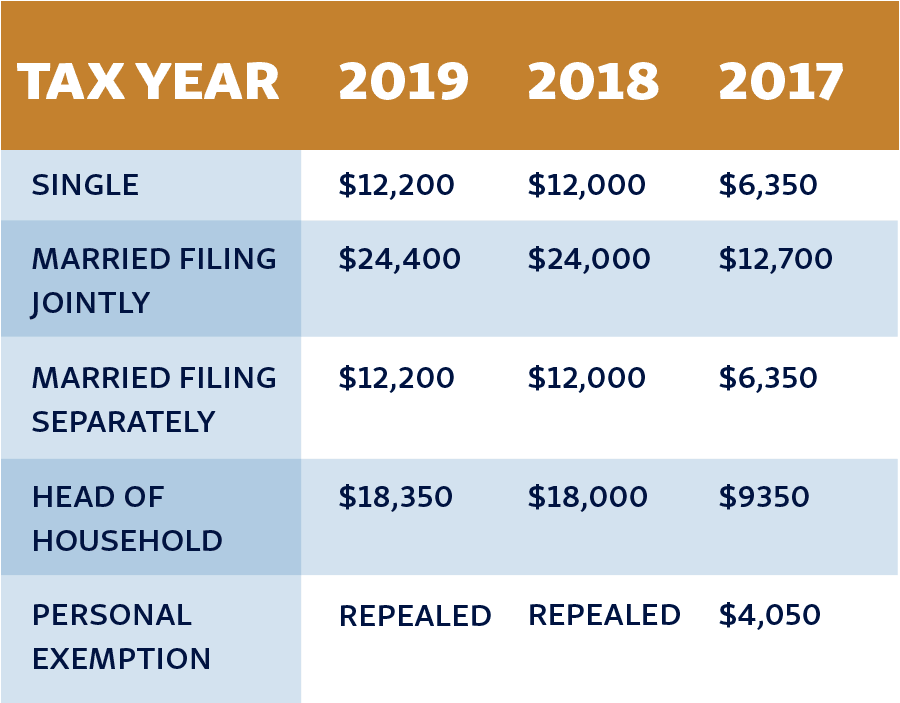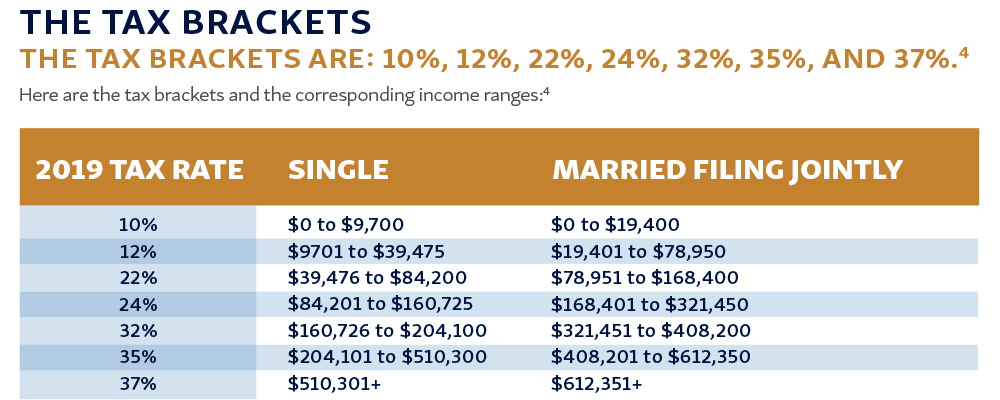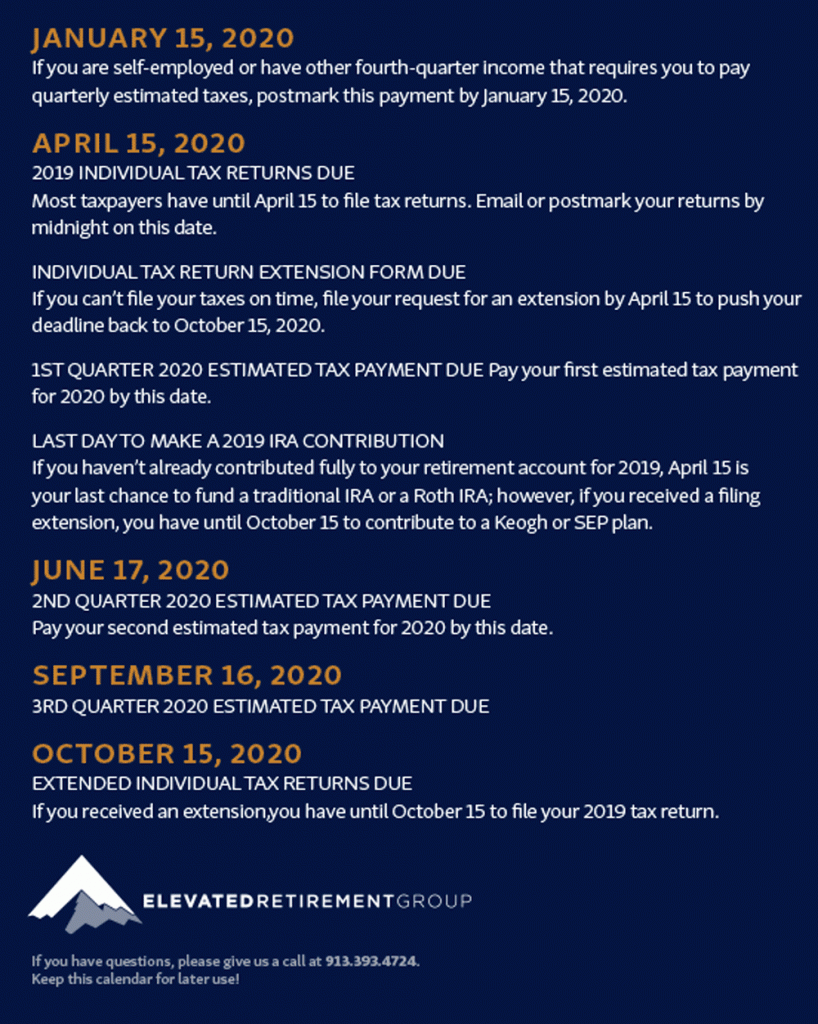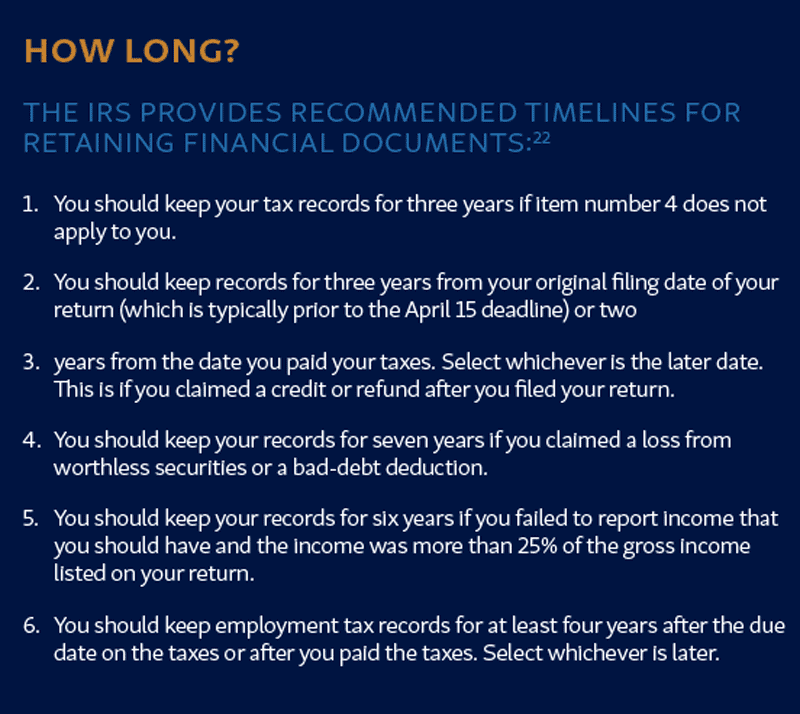
Report: 2019 Year End Tax Planning
YEAR-END PREPARATIONS
The countdown begins. Once the clock rolls us into 2020, tax season gets underway. The old calendar year, 2019, will have officially been put to rest.
Deductions from your paychecks and other income sources will begin counting for the New Year.
Once it’s 2020, we can celebrate and look to even better days ahead. But we dare not neglect our fiduciary obligations to the old year.
In this guide, we’ll explore ways you could be affected by the 2019 changes to the tax law. Keep in mind, this guide is for informational purposes only and is not a replacement for real-life advice, so make sure to consult your tax, legal, and accounting professionals before modifying your strategy.
On January 1, it’ll be 104 days until April 15, 2020. That’s the deadline the Internal Revenue Service sets for tax returns. If you miss that deadline, you will face consequences.
HOW TO PREPARE FOR THE 2020 TAX SEASON
While April 15, 2020 looks pretty much the same as any other day on the calendar, it marks the official end of 2019 for the American taxpayer (for the most part).
What’s on the horizon? 2020 will be a year of evaluation as the United States holds its presidential election. Will tax issues play a key role in the national conversation? It’s very possible.
President Donald Trump and White House economic advisor Larry Kudlow have announced what are being called “middle-income” tax credits for 2020. Also being called “Tax Cuts 2.0,” Trump is seeking to make elements of the 2017 Tax Cuts and Job Act permanent. Without legislation, the cuts are set to sunset in 2025.1,2
While that represents a potential future for the 2017 Tax Cuts and Jobs Act, there are still elements of that bill that are coming to pass and several that will roll out as you are preparing to file for your 2019 taxes.
One of the big changes coming to pass this year involves changes that the 2017 Tax Cuts and Jobs Act made to the Affordable Care Act. The individual mandate, sometimes referred to as the shared responsibility payment, has been repealed. For those who were required to have health insurance under the Affordable Care Act, yet weren’t insured, a tax penalty applied. For Tax Year 2019, that no longer applies.3
Another change related to the Affordable Care Act is the threshold for when taxpayers can take a deduction for expenses related to medical or dental bills. The 2017 Tax Cuts and Jobs Act had reduced that threshold from 10% down to its previous 7.5%. For 2019, the threshold returns to 10%.3
Married couples who divorced in 2019 will face a much different set of rules when it comes to alimony. Where alimony payments were once tax deductible, that is no longer the case going forward. Likewise, alimony for the recipient spouse won’t count as taxable income.3
In addition, there are larger limits for workplace retirement plan contributions (now $19,000, with an additional $6,000 for those 50 and older) and Health Savings Accounts ($3,500 for self, $7,000 for family).3
If you spend your Health Savings Account funds on nonmedical expenses before age 65, you may be required to pay ordinary income tax as well as a 20% penalty. After age 65, you may be required to pay ordinary income taxes on HSA funds used for nonmedical expenses. HSA contributions are exempt from federal income tax; however, they are not exempt from state taxes in certain states.
The raising of income requirements for the tax brackets also means wage earners may fall into lower brackets. Here’s one example. A single filer at $83,000 in taxable income would fall into the 24% bracket for tax year 2018. The filer would be in the 22% tax bracket in 2019.4,5
Another single filer with an income of more than $500,000 (but less than $510,300) would have been in the 37% bracket in 2018. For 2019, they are in the 35% bracket. Meanwhile, a single filer earning between $160,000 and $160,725 in 2018 would have been well within the 32% bracket. In tax year 2019, they are in the 24% bracket.4,5
These new rates are scheduled to expire in 2025 unless Congress acts to make them permanent. Exemptions also changed under the new tax code.
Here is an overview of the standard deductions since 2016:4,6

The higher standard deductions may make it more attractive (compared to itemizing) for many taxpayers. Taxpayers who had itemized, to take advantage of deductions for high mortgage interest, large charity donations, or local taxes, may be unable to reach the standard deduction’s higher limit.
Under previous tax law, taxpayers could claim exemptions for themselves, spouses, and dependents. This was changed in the 2017 Tax Cuts and Jobs Act.7
The act eliminated all personal and dependent exemptions. The higher deduction is intended to fill that exemption gap.

HOW TO PREPARE
While the first filing after the 2017 Tax Cuts and Jobs Act came into effect was very different, the process has not changed much from year to year. The filing and other deadlines haven’t changed, for instance. You should begin preparing early to avoid any unforeseen challenges.8
Get a checkup:
As a starter, the IRS urges taxpayers to conduct paycheck checkups.9 The agency provides tools and resources to help you calculate the correct amount to have withdrawn from your paycheck.
The calculator will help you determine if your employer is withholding adequate amounts from your paycheck. The calculator asks for your projected gross income, your current withholding number, the current amount of federal taxes withheld, and other paycheck-related questions.
The calculator leads you through various screens that require you to enter requested numbers into boxes. The calculator looks similar to a tax-filing form.
 The final figure:
The final figure:
Once the calculator generates the estimated taxes, you’ll either owe or be refunded, it offers suggestions on how to change your withholding amount or request to get additional money withheld from your check.
For the tax year 2018, the average IRS refund usually exceeds $2,800.
If the calculator shows you’ll owe taxes at the end of the year, you may file a new Form W-4, Employee’s Withholding Allowance Certificate,10 following the advice provided by the calculator. The IRS-provided calculator is designed to provide feedback based on certain assumptions. It is not intended to provide specific tax, legal, or accounting advice. The calculator is not a replacement for real-life advice, so please make sure to consult a professional before modifying your tax strategy.
Advice may include changing the number of allowances you’re claiming (line 5) or requesting your employer withhold additional money (line 6).
Taxpayers who receive pension income may use Form W-4P.11 Once completed, send the form to your payer if you’re adjusting or making changes.
WHAT DO YOU NEED TO HAVE TO USE THE CALCULATOR?
To generate a calculation, you’ll need to have these documents:
- A recent pay stub
- A recent income tax return
- A copy of a completed Form 1040, which will help you estimate your income
The calculator will not request you provide personal or private information. It will, however, ask you the number of children you expect to claim for the Child Tax Credit and the Earned Income Tax Credit.
Taxpayers with more complex tax issues may follow the instructions in Publication 505, Tax Withholding and Estimated Tax.12
WHO SHOULD USE THE CALCULATOR?
The IRS urges taxpayers who have questions or concerns about changes in the tax code to use the calculator. Specifically, the agency advises you to check your withholding if you:
- Have a two-income household.
- Have two or more jobs.
- Work only part of the year.
- Can claim child tax and other credits.
- Have dependents who are 17 and older.
- Itemized your deductions last year.
- Are a high earner or have a complex tax return.
- Received a large tax refund or paid a large tax bill for 2018.
LOOKING AT ITEMIZING
The IRS has revamped the way itemized deductions can be claimed on Schedule A. Schedule A is a separate tax form attached to standard 1040 forms.13
Changes to the itemized deductions for 2019 include:
- Itemized deductions are not limited if your adjusted gross income (AGI) exceeds a certain amount. Your adjusted gross income is the portion of your income that is taxable.14
- Total deductions from state and local income, sales, and property taxes are limited to $10,000. It’s $5,000 if you’re married and filing separately.
- Job-related and other miscellaneous expenses – that were subject to the 2% AGI limit – can no longer be deducted.
- Certain other expenses, such as gambling losses, can still be deducted.
- Deductions for the interest on mortgage debt –incurred after December 15, 2018 – are limited to up to $750,000 of the home’s loan amount. The new limit doesn’t apply if you contracted to close on your home after December 15, 2018 and before April 2, 2019.
- The cash charity contribution limit is 60% of your AGI.
Other changes in deductibles carried over from the previous year:
You may no longer deduct moving expenses unless you’re on active duty in the U.S. military.
The Child Tax Credit under the 2018 tax reform rose to $2000 per qualifying child. The refundable portion of the credit (referred to as the additional child tax credit) is limited to $1,400 and applies when taxpayers are unable to fully use the $2,000 nonrefundable tax credit to offset their taxes. The credits phase out at income thresholds of $200,000 or $400,000 for married taxpayers filing jointly.15
The tax code established a tax credit of up to $500 for other dependents who may not qualify for the child tax credit. Children who you plan to claim as dependents must have Social Security numbers prior to the due date of your tax return (which is April 15, 2020). Children who don’t have Social Security numbers, but have individual taxpayer identification numbers, may be claimed under the new credit for other dependents.
 PREPARING FOR THE TAX SEASON
PREPARING FOR THE TAX SEASON
Planning well in advance of the tax season may help better prepare you for the unexpected. Here are several reasons to begin planning early: 18
- Your home, job, or relationships changed in 2019.
- You need to start saving money if you think you may owe taxes.
- You want to ensure you qualify for tax deductions.
You can make changes throughout the year to help ensure your tax preparations go smoothly. Specifically, you can make periodic assessments of your paycheck withholdings, so that you expect to get a refund.
You should keep track of and store your tax and other financial records to avoid delays or frantic preparations as the filing deadline approaches. Records may include W-2 forms, canceled checks, certain receipts, and previous year returns.
Here is a list of other items to start gathering:
- Pay stubs
- Mortgage payment records
- Closing paperwork on home purchases
- Receipts for items or services you may want to claim as itemized deductions
- Records on charity giving and donations
- Mileage logs on cars used for business
- Business travel receipts
- Credit card and bank statements to verify deduction
- Medical bills
- 1099-G forms for state and local taxes
- 1099 forms for dividend or other income
During the first three months of 2020, make sure you receive your W-2 and 1099 forms as well as other
tax documents. Leave adequate time to collect documents and prepare to file your taxes prior to the April 15, 2020 deadline.
TIGHTENING THE NUTS AND BOLTS
While the 2018 tax season is more than six months behind us, the final months of 2019 provide taxpayers with some unique opportunities to avoid unpleasant surprises and scrambling as the finish line draws near.
Here are some ways to prepare this year for next year’s tax season:16
Look at last year:
Take one more look at last year’s (2018) return. In the months ahead, you may still have the opportunity to contribute more to your retirement plan, which may lower your taxable income.
Donating to charity:
How about “bunching” your charitable donations? For Tax Year 2019, the standard deduction of individual taxpayers rose to $12,200.
For married couples, deductions must exceed $24,400. These deduction limits only apply if you itemize your deductions.17
Bunching provides you with the ability to optimize your deduction allowances by making two or more years’ worth of charity donations in one year to boost the amount.
Let’s say you’re married, you plan to itemize your deductions (as opposed to taking the $24,400 standard deduction), and you plan to make $15,000 in annual donations. By donating $30,000 in one year and skipping the next, you may be able to qualify for the higher amount.18
The IRS allows you to deduct an amount to charity up to 60% of your adjusted gross income; however, the agency sets 20% and 30% limits in some cases. The IRS provides a list of deduction limit codes for different kinds of organizations.19
Capital Losses:
If you’re investing in the financial markets, you may want to consider deducting capital losses; you have the opportunity to claim deductions, if you experienced losses.
You can claim losses only if they exceed capital gains. You’re allowed to claim the difference up to $3,000 per year if you’re married filing jointly or $1,500 if you’re filing separate returns.20 Net losses that exceed $3,000 can be carried over into future years.21
Deductions for capital losses can only be applied to investment property sales, but not the sale of investment property that was held for personal use.
Get Organized:
Find a place to store your tax documents until it’s time to prepare to file. A good record-keeping system may alleviate concerns later as the deadline gets closer.
If you have your documents or prior-year returns stored on your computer, make sure you back them up on a thumb drive or other device or system in case your computer is hacked or stolen.
Other Taxes:
Keep watch on local and state government requirements. Changes produced on the federal level with the Tax Cuts and Jobs Act affect state and local governments.
CONCLUSION
We hope you found this report to be educational and informative. You may incorporate the principles and tips in this report into your tax preparation strategy.
Planning well in advance may enable you to take advantage of the opportunities and benefits available under the new tax code.
Discussing your unique situation with both a financial professional and a tax professional may help you
make the best choices as tax season approaches. The information in this material is not intended as tax or legal advice. It may not be used for the purpose of avoiding any federal tax penalties. Please consult with legal or tax professionals with expertise in this area for specific information regarding your situation.
If you or anyone close to you would like to discuss how to maximize their financial situation, please give our office a call at 801.639.0095.
FOOTNOTES AND SOURCES
By visiting these links, you will leave our server, as they are located on another server. We have not independently verified the information available through these links. They are provided to you as a matter of interest. Please visit the links below to leave and proceed to the selected site.
1 https://www.reuters.com/article/us-usa-economy-tax/trump-says-he-will-unveil-middle-income-tax-plan-in-2020-idUSKCN1VY017
2 https://www.foxbusiness.com/economy/trumps-tax-cuts-2-0-expected-2020
3 https://www.msn.com/en-us/money/personalfinance/7-ways-your-taxes-will-change-in-2020/ar-BBVY3Ir
4 https://www.irs.gov/pub/irs-drop/rp-18-57.pdf
5 https://www.irs.gov/irb/2018-10_IRB
6 https://www.consumerismcommentary.com/standard-deductions-exemptions-federal-income-tax/
7 https://www.hrblock.com/tax-center/irs/tax-reform/new-standard-deduction-eliminated-exemptions/
8 https://www.irs.gov/individuals/steps-to-take-now-to-get-a-jump-on-next-years-taxes
9 https://www.irs.gov/individuals/tax-withholding-estimator
10 https://www.irs.gov/pub/irs-pdf/fw4.pdf
11 https://www.irs.gov/pub/irs-pdf/fw4p.pdf
12 https://www.irs.gov/pub/irs-pdf/p505.pdf
13 https://www.investopedia.com/terms/s/schedulea.asp
14 https://www.investopedia.com/terms/a/agi.asp
15 https://www.irs.gov/newsroom/ten-facts-about-the-child-tax-credit 16 https://www.efile.com/tax-return-preparation-checklist/
17 https://www.irs.gov/pub/irs-drop/rp-18-57.pdf
18 https://www.forbes.com/sites/nextavenue/2018/03/15/what-the-new-tax-law-means-for-your-charitable-giving/
19 https://www.irs.gov/charities-non-profits/tax-exempt-organization-search-deductibility-status-codes
20 https://www.irs.gov/newsroom/helpful-facts-to-know-about-capital-gains-and-losses
21 https://www.forbes.com/sites/nextavenue/2018/03/15/what-the-new-tax-law-means-for-your-charitable-giving/#30b1cf464034
22 https://www.irs.gov/businesses/small-businesses-self-employed/how-long-should-i-keep-records

